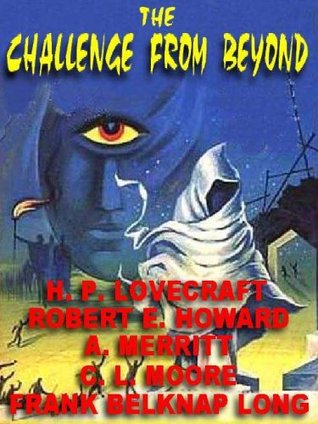What do you think?
Rate this book


ebook
First published September 1, 1935
The Challenge from BeyondThis is the first time I've come across a world called Yekub and its inhabitants, worm-like creatures.
By C.L. Moore, A. Merritt, H.P. Lovecraft,
Robert E.Howard, and Frank Belknap Long

[Cover for “The Challenge from Beyond,” found on Goodreads. I could not find the original source]
Didn’t…“Challenge from Beyond” turn out well, considering? Yours was by far the best installment insofar as originality and workmanship are concerned. You had the hardest section, too—having to explain all the unconnected ramblings of your predecessors. Several of the installments, including mine, were carelessly written and loosely phrased, but yours, as usual, was a miracle of exact wording. And wasn’t it interesting to see how the personality of each writer colored his installment. (Derie, 2018, para. 1).
“This manuscript portion of a round-robin story is headed: "3 - by H. P. Lovecraft". The Challenge from Beyond was written during August 1935, as part of a collaboration with Catherine L. Moore, Abraham Merritt, Robert E. Howard and Frank Belknap Long, Jr. (see HPL to DR, 1935 Aug 29). The complete story first appeared in Fantasy Magazine, 5, No. 40 (Sep 1935)”
Moore and Merritt wrote a mediocre intro, which they passed to Lovecraft, who promptly shoehorned it into a sequel to his own story, The Shadow Out of Time. Said sequel is mostly more of the same. Toward the end of his section, Lovecraft starts describing the protagonist's horror and revulsion at finding himself occupying an alien body, exactly as he did in "The Shadow out of Time". Do you think Lovecraft ever got tired of repeating himself? I think Howard got tired of Lovecraft repeating himself. He wrote the next section, which starts with a clear "Bro, can you not?" to Lovecraft:
He fought down an unreasoning horror. Judged from a cosmic standpoint, why should his metamorphosis horrify him? Life and consciousness were the only realities in the universe. Form was unimportant. His present body was hideous only according to terrestrial standards. Fear and revulsion were drowned in the excitement of titanic adventure.
E for effort, Howard, but the damage was done, and the sudden tone shift is jarring.